
CRYSTENGCOMM
Scope & Guideline
Illuminating the path of crystallization advancements since 1999.
Introduction
Aims and Scopes
- Synthesis of Crystalline Materials:
Research on the synthesis methods for various crystalline materials, including metal-organic frameworks (MOFs), coordination polymers, and hybrid materials, often highlighting innovative techniques and approaches. - Characterization Techniques:
Characterization of synthesized materials through advanced techniques such as X-ray diffraction, NMR spectroscopy, and electron microscopy to elucidate structural and functional properties. - Photonic and Electronic Applications:
Exploration of the photonic and electronic properties of crystalline materials, focusing on their use in sensors, light-emitting devices, and catalysts. - Environmental and Energy Applications:
Application of crystalline materials in environmental remediation, energy storage, and conversion, emphasizing their roles in sustainable technologies. - Understanding Noncovalent Interactions:
Investigation into the role of noncovalent interactions, such as hydrogen bonding and halogen bonding, in influencing the properties and behaviors of crystalline materials. - Polymorphism and Phase Transitions:
Studies on polymorphism, phase transitions, and their impact on the properties of materials, particularly in pharmaceuticals and energetic materials.
Trending and Emerging
- Hybrid Materials and Composites:
There is a growing trend towards the development of hybrid materials that combine organic and inorganic components, enhancing functionality for applications in catalysis, sensing, and energy storage. - Sustainable and Green Chemistry:
Research focusing on environmentally friendly synthesis methods, including the use of renewable resources and green solvents, is becoming increasingly prominent. - Advanced Photonic Applications:
Enhanced interest in the photonic applications of crystalline materials, particularly in photonic devices, sensors, and light-emitting applications, is evident in recent publications. - Machine Learning and Computational Studies:
The integration of machine learning and computational methods in predicting crystal structures and properties is emerging as a significant area of research. - Responsive Crystalline Materials:
Studies on stimuli-responsive materials, which change properties in response to environmental factors such as temperature, light, or chemical presence, are gaining traction. - Nanostructured and Mesoporous Materials:
There is an increasing focus on the synthesis and application of nanostructured and mesoporous materials, particularly for catalysis and drug delivery.
Declining or Waning
- Traditional Inorganic Crystals:
Research focused on classical inorganic crystal structures without significant functionalization or application has become less common, as the field shifts towards more complex, functional materials. - Low-Dimensional Materials:
The interest in purely low-dimensional materials, such as one-dimensional nanowires or two-dimensional sheets, has waned in favor of hybrid structures that combine multiple dimensions and functionalities. - Basic Coordination Chemistry:
Studies that solely focus on the basic coordination chemistry of simple ligands and metal ions, without exploring their applications or interactions in complex systems, are less frequently published. - Static Crystal Structures:
There is a noticeable decrease in papers that primarily report static crystal structures without considering their dynamic behaviors or responses to external stimuli. - Non-Photonic Applications:
Research on crystalline materials that do not leverage their photonic or electronic properties appears to be declining, as the field increasingly emphasizes applications in sensing and energy conversion.
Similar Journals
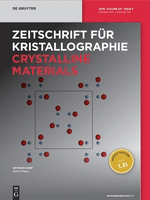
Zeitschrift fur Kristallographie-Crystalline Materials
Exploring the Depths of Crystalline InnovationZeitschrift für Kristallographie-Crystalline Materials is a prestigious academic journal published by Walter de Gruyter GmbH, focusing on the intricate field of crystallography and its applications within condensed matter physics, inorganic chemistry, and materials science. Established in Germany, this journal spans a rich history from its inception in 1930 to its convergence years from 2012 to 2024, presenting cutting-edge research and developments in crystalline materials. With an impact factor reflective of its critical role within its field—ranking Q3 in the prestigious quartiles for 2023 across multiple categories—this journal serves as an essential platform for researchers, professionals, and students seeking to expand their knowledge and contribute to the advancement of crystalline materials. While currently not offering open access, the journal remains committed to disseminating high-quality, peer-reviewed articles that inspire innovation and collaboration within the scientific community.

JOURNAL OF MATERIALS SCIENCE-MATERIALS IN ELECTRONICS
Exploring Innovative Pathways in Materials ScienceJOURNAL OF MATERIALS SCIENCE-MATERIALS IN ELECTRONICS, published by Springer, is a distinguished international journal that serves as a vital platform for the dissemination of cutting-edge research in the field of materials science, with a keen focus on electronics. Since its inception in 1990, this journal has consistently contributed to the advancement of knowledge across a range of interdisciplinary categories, including Atomic and Molecular Physics, Optical and Magnetic Materials, and Biomedical Engineering, achieving notable quartile positions in various 2023 Scopus rankings. With an impact factor that signifies its scholarly influence, this journal provides a rigorous peer-reviewed environment for researchers and practitioners to share innovative ideas, experimental findings, and theoretical developments. Although it does not currently offer open access options, the depth and breadth of topics covered—including condensed matter physics and bioengineering—make it an essential resource for those at the forefront of materials research. With a commitment to bridging the gap between theory and practical application, the JOURNAL OF MATERIALS SCIENCE-MATERIALS IN ELECTRONICS continues to pave the way for future explorations in the ever-evolving landscape of materials science.

CHINESE JOURNAL OF STRUCTURAL CHEMISTRY
Unveiling the Secrets of Structural DynamicsThe CHINESE JOURNAL OF STRUCTURAL CHEMISTRY, published by Elsevier, stands as a vital resource in the field of structural chemistry, notably contributing to the advancement of knowledge since its inception in 1996. With its ISSN 0254-5861 and E-ISSN 0254-5861, the journal has established a firm reputation, garnering a Q2 ranking in the 2023 Chemistry (miscellaneous) category, which highlights its influence in the academic community (rank #155/408, 62nd percentile in Scopus). This journal serves as an invaluable platform for researchers and professionals by disseminating high-quality research findings, theoretical studies, and applied methodologies that address both fundamental aspects and emerging trends in structural chemistry. With contributions from distinguished scholars, it aims to foster innovation and collaboration, while providing a space for novel discoveries in the field. Although it does not currently offer Open Access, its robust content continues to attract a diverse readership eager to engage with cutting-edge scientific developments.

New Materials Compounds and Applications
Bridging Theory and Practice in Materials ChemistryNew Materials Compounds and Applications is a pioneering journal published by JOMARD PUBLISHING, focusing on the latest advancements in materials science, particularly in the realms of analytical, inorganic, and organic chemistry. Since its inception in 2019, this journal has quickly established itself as a valuable resource for researchers and professionals seeking to explore innovative compounds and their applications across various fields. With an ISSN of 2521-7194 and an E-ISSN of 2523-4773, New Materials Compounds and Applications is indexed in Scopus, demonstrating its scholarly impact, albeit currently positioned in the Q3 and Q4 quartiles for several chemistry categories. The journal serves as a platform for disseminating research findings and fostering collaboration among scientists in Azerbaijan and beyond. Although it operates under a traditional access model, the journal aims to bridge the gap between theoretical studies and practical applications, making it essential reading for students and professionals looking to stay updated in the dynamic landscape of materials chemistry.
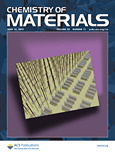
CHEMISTRY OF MATERIALS
Uncovering Breakthroughs in Material ChemistryChemistry of Materials, published by the American Chemical Society, stands at the forefront of innovative research in the disciplines of chemical engineering, materials science, and chemistry. With an impressive impact factor, this esteemed journal is recognized globally, having achieved Q1 rankings in three significant categories for 2023: Chemical Engineering, Materials Chemistry, and General Chemistry. This positions the journal in the top tier of academic publications, reflecting its influence and rigor in advancing the field. Since its inception in 1989, Chemistry of Materials has been a platform for groundbreaking studies, contributing essential insights and discoveries that shape modern materials science. While currently not an open-access journal, it remains an invaluable resource for researchers, professionals, and students seeking to explore cutting-edge materials research and applications. Its well-curated collection of articles underscores the journal's commitment to enhancing understanding and promoting innovations in material chemistry and its associated fields.
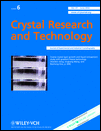
CRYSTAL RESEARCH AND TECHNOLOGY
Unveiling the Secrets of Crystal Growth and StructureCRYSTAL RESEARCH AND TECHNOLOGY, published by WILEY-V C H VERLAG GMBH, is a distinguished journal in the fields of Chemistry, Condensed Matter Physics, and Materials Science, with over five decades of continuous publication from 1966 to 2024. With its ISSN 0232-1300 and E-ISSN 1521-4079, the journal serves as a crucial platform for disseminating significant research findings, theoretical advances, and technological innovations related to crystal growth, structure, and properties. Holding a Category Quartile ranking of Q3 in the 2023 assessments across its disciplines, CRYSTAL RESEARCH AND TECHNOLOGY is recognized for its contribution to the scientific community, making it an essential resource for researchers, professionals, and students alike. While this journal is not open access, its robust publishing framework ensures that high-quality peer-reviewed articles remain accessible to a global audience. The importance of this journal lies in its commitment to advancing knowledge and fostering collaborations in crystallography and related fields.
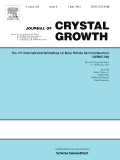
JOURNAL OF CRYSTAL GROWTH
Exploring the Intricacies of Crystal GrowthJOURNAL OF CRYSTAL GROWTH, published by Elsevier, stands as a vital platform in the realm of condensed matter physics, inorganic chemistry, and materials chemistry. With its inception dating back to 1967 and a promising convergence continuing through 2024, this journal encompasses the latest research and advancements in crystal growth phenomena. Although it does not currently offer open access options, its rigorous peer-review process ensures high-quality scholarly contributions that are essential for researchers, professionals, and students alike. The journal's solid standing is reflected in its Scopus rankings, with placements in the third and second quartiles across relevant fields and notable percentiles. Operating from the heart of the Netherlands, JOURNAL OF CRYSTAL GROWTH not only fosters academic dialogue but also enhances the understanding of crystallization processes crucial for materials engineering and applied sciences, making it an indispensable resource for anyone dedicated to exploring the intricacies of crystal growth.
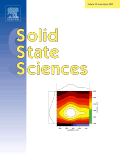
SOLID STATE SCIENCES
Advancing the Frontiers of Materials ResearchSOLID STATE SCIENCES is an influential academic journal published by Elsevier, focusing on advancements in the fields of chemistry, condensed matter physics, and materials science. With an ISSN of 1293-2558 and an E-ISSN of 1873-3085, this journal has been at the forefront of disseminating innovative research since its inception in 1999 and is projected to continue until 2024. Positioned in the prestigious Q2 category in multiple disciplines for 2023, SOLID STATE SCIENCES ranks #87 in condensed matter physics, #101 in general chemistry, and #124 in general materials science within Scopus. Researchers and professionals in these fields will find this journal indispensable, offering open access options that enhance global visibility and accessibility of cutting-edge research, fostering collaboration and innovation. With its commitment to showcasing substantial contributions and novel methodologies, SOLID STATE SCIENCES plays a vital role in shaping the future of materials research.

JOURNAL OF STRUCTURAL CHEMISTRY
Fostering Insight and Excellence in Structural ChemistryThe JOURNAL OF STRUCTURAL CHEMISTRY, published by PLEIADES PUBLISHING INC, is a premier resource in the fields of Inorganic Chemistry, Materials Chemistry, and Physical and Theoretical Chemistry. Established in 1960, this journal has been providing a platform for groundbreaking research, facilitating the advancement of knowledge and innovation up to the year 2024. With an ISSN of 0022-4766 and an E-ISSN of 1573-8779, this journal strives to maintain high academic standards, as evidenced by its quartile rankings in 2023, where it ranks Q4 across various chemistry categories. While it currently does not offer open access, the journal's insightful articles are crucial for professionals and students seeking to enhance their understanding and expertise in structural chemistry. Subscribers can expect a comprehensive collection of peer-reviewed research, empirical findings, and theoretical discussions that contribute significantly to the scientific community. With its strong historical foundation and ongoing commitment to quality, the JOURNAL OF STRUCTURAL CHEMISTRY continues to be an essential resource for those passionate about the complexities of structural chemistry.
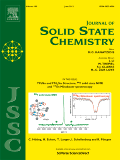
JOURNAL OF SOLID STATE CHEMISTRY
Driving Excellence in Solid State InvestigationsWelcome to the Journal of Solid State Chemistry, a prestigious publication that has been at the forefront of solid state chemistry research since its inception in 1969. Published by Academic Press Inc. Elsevier Science in the United States, this journal offers a rigorous platform for the dissemination of high-impact research articles and reviews in a wide array of categories such as Ceramics and Composites, Condensed Matter Physics, and Materials Chemistry, among others. With an impressive Q2 ranking across multiple categories in 2023 and a commendable performance in Scopus rankings—including a top position in Inorganic Chemistry—this journal serves as an essential resource for researchers, professionals, and students eager to advance their understanding in solid state phenomena. Although it does not currently offer Open Access options, the breadth and quality of the published research ensure significant visibility and scholarly impact. As we continue to converge into 2024, we invite you to explore groundbreaking studies that push the boundaries of knowledge in solid state chemistry.